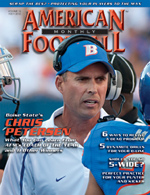Article CategoriesAFM Magazine
|
Developing Functional Power for Footballby: Rick ReganPhysical Training Consultant with Dustin Smith, High School Coach and Teacher © More from this issue The search for conditioning drills that enhance functional power for sports is an on-going process. A key consideration in this endeavor is the principle of specificity of training. Simply stated, specificity of training means that the body gets better at doing physical activities that it is required to do on a regular basis. If these activities are progressively overloaded as they are repetitively performed, the resultant gains are further magnified.
|
|
|||||||
| HOME |
MAGAZINE |
SUBSCRIBE | ONLINE COLUMNISTS | COACHING VIDEOS |
Copyright 2025, AmericanFootballMonthly.com
All Rights Reserved





